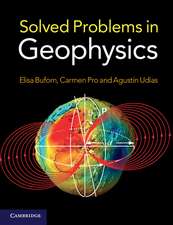Lattice Boltzmann Methods for Shallow Water Flows
Autor Jian Guo Zhouen Limba Engleză Hardback – 27 oct 2003
| Toate formatele și edițiile | Preț | Express |
|---|---|---|
| Paperback (1) | 602.46 lei 6-8 săpt. | |
| Springer Berlin, Heidelberg – 14 oct 2010 | 602.46 lei 6-8 săpt. | |
| Hardback (1) | 613.80 lei 6-8 săpt. | |
| Springer Berlin, Heidelberg – 27 oct 2003 | 613.80 lei 6-8 săpt. |
Preț: 613.80 lei
Preț vechi: 722.11 lei
-15% Nou
Puncte Express: 921
Preț estimativ în valută:
108.62€ • 127.36$ • 95.39£
108.62€ • 127.36$ • 95.39£
Carte tipărită la comandă
Livrare economică 12-26 februarie
Preluare comenzi: 021 569.72.76
Specificații
ISBN-13: 9783540407461
ISBN-10: 3540407464
Pagini: 128
Ilustrații: XI, 112 p.
Dimensiuni: 155 x 235 x 13 mm
Greutate: 0.36 kg
Ediția:2004
Editura: Springer Berlin, Heidelberg
Colecția Springer
Locul publicării:Berlin, Heidelberg, Germany
ISBN-10: 3540407464
Pagini: 128
Ilustrații: XI, 112 p.
Dimensiuni: 155 x 235 x 13 mm
Greutate: 0.36 kg
Ediția:2004
Editura: Springer Berlin, Heidelberg
Colecția Springer
Locul publicării:Berlin, Heidelberg, Germany
Public țintă
ResearchCuprins
1 Introduction.- 2 Shallow Water Flows.- 3 Lattice Boltzmann Method.- 4 Force Terms.- 5 Turbulence Modelling.- 6 Boundary and Initial Conditions.- 7 Applications.- A LABSWE on Hexagonal Lattice.- B LABSWE Code.- B.1 LABSWE Module.- B.2 An Example.- References.
Recenzii
From the reviews:
"The book describes the lattice Boltzmann method for shallow water flows with or without turbulence. … The book demonstrates important recent advances in computational fluid dynamics and can be used as an invaluable reference for scientists and engineers, and as a textbook for graduates in engineering sciences such as coastal, civil and environmental engineering." (Felix Kaplanski, Zentralblatt MATH, Vol. 1052, 2005)
"The book describes the lattice Boltzmann method for shallow water flows with or without turbulence. … The book demonstrates important recent advances in computational fluid dynamics and can be used as an invaluable reference for scientists and engineers, and as a textbook for graduates in engineering sciences such as coastal, civil and environmental engineering." (Felix Kaplanski, Zentralblatt MATH, Vol. 1052, 2005)
Notă biografică
Dr. Jian Guo Zhou graduated from Wuhan University with first degree in River Mechanics and River Engineering and subsequently finished his MSc in Hydraulics and Fluvial Mechanics at Tsinghua University. He received his PhD in Fluid Mechanics from Leeds University. Since then, he has been working in computational fluid dynamics. His representative contributions are the surface gradient method for the treatment of the source terms in shallow water equations, the elastic-collision scheme for slip/semi-slip boundary conditions for lattice Boltzmann methods, the centered scheme for the force terms in the lattice Boltzmann equation, and lattice Boltzmann methods for shallow water equations with or without turbulence modelling.
Caracteristici
Pioneer book of the topic Includes supplementary material: sn.pub/extras










